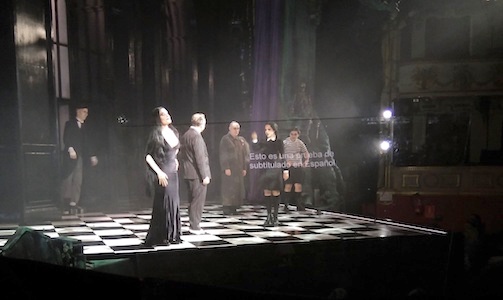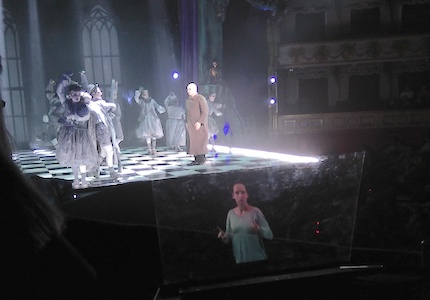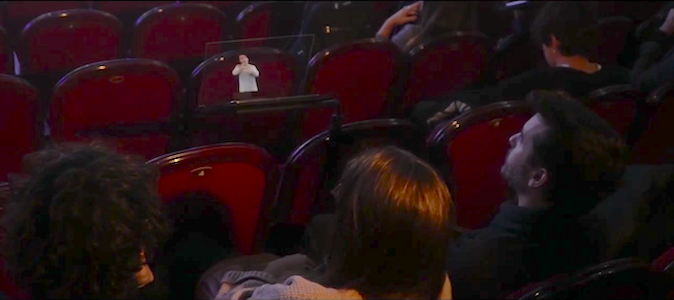Since December 3rd the fun Broadway show, The Addams Family, is being presented with accessibility in the theater Teatro Calderon of Madrid. Thanks to an innovative technology called Stage-Sync, people with auditive and visual disabilities, can now enjoy this show as much as people without disabilities.
If you are a person with auditive and/or visual disability, it is most likely you have tried most of the available technologies in movie theaters or you have even been to a play that offers some accessible elements. Unfortunately, there are not many plays with accessibility for people with auditive and/ or visual impairment; and the ones that do have it are limited to a reduced number of presentations. Due to this we would like to point out the case of The Addams Family that is offering accessibility in all its presentations and that uses technology that consists of multiple elements to offer the most complete experience.

Stage-Sync technology consists of 4 elements:
- Close Caption for the deaf
- Audio description for the blind
- Sign Language Interpretation
- Vibrating Elements

If you are blind or visually impaired, Stage-Sync allows you to listen to the audio description synchronized with the play, directly on your mobile phone. If you are deaf or hearing impaired, you have the option of seeing the closed caption or the sign language on a transparent lectern where they will be projected onto, just as if they were holograms; the captions or the image of the sign language interpreter.
Additionally, there is a “Vibrating Drawstring Bag” that is very useful for the deaf, because they can feel the show’s music through the rhythm of the bass frequency of the instruments that the vibrating bag transmit. I think this is awesome!
All the accessible elements mentioned automatically synchronize with the play, this way offering the best experience possible for the person attending the show.

Stage-Sync was developed by a research group from SoftLab of the university Universidad Carlos III de Madrid. To get to know more about this technology, we have contacted Dr. Angel Garcia Crespo, Director of the Institute of Technological Development and Promotion of Innovation (Instituto de Desarrollo Tecnológico y Promoción de la Innovación) of the university Universidad Carlos III de Madrid. Dr. Garcia is also responsible for the research group SoftLab. He has kindly accepted to answer some questions related to Stage-Sync.
Dicapta: What is the difference between Stage-Sync and other tools in the market to make theater shows accessible?
Angel García: Until now from a technological point of view, in theaters, technologies were used where the person had to do the synchronization to each show manually, because there are no two shows the same. Each time a play is made it has different rhymes that didn’t allow an automatic synchronization with what was happening on stage. With Stage-Sync the synchronization takes place automatically without anyone having to do anything, which means that all representation in a play are accessible instead of just a few.
Dicapta: In what other cases can Stage-Sync be used?
A.G.: Stage-sync can be used for events that have a previous script and that will be repeated.
Dicapta: If a theater wants to use Stage-Sync, what do they need?
A.G.: It must have a Stage-Sync server that is who is “watching” what is happening on stage and comparing it with the previous representations to know when it is at that exact representation. A router is also required, because the accessible elements, adapted captions, sign language, audio description or captions in another language are sent to the mobile devices, that the theater may provide or belong to the spectator. Furthermore, the theater may have magnifying lecterns where the captions can be seen or the sign language “floating” in front of the spectator.
Dicapta: Are there other plays scheduled using this technology?
A.G.: Today the entire tour all over Spain of The Addams Family is confirmed. That is 16 cities, and we have begun negotiations to include the system in new plays.
Dicapta: Have you had any approach with American companies to use the Stage-Sync technology?
A.G.: The fact of us beginning by making The Addams Family accessible, a Broadway musical, is an example that great productions can be accessible to everyone. I am convinced that soon the main market of great theatrical productions will make it possible for everyone to enjoy them.
Offering accessibility to the presentations of The Addams Family has required the collaboration of multiple entities: LetsGo Company (producer of The Addams Family), university Universidad Carlos III de Madrid, Escena Global y Comunicados, the creative agency C&W, the community of Madrid and the European Regional Development Fund. We wish that this experience multiply in many other places.
Sources:
- "Inteligencia Artificial y teatro accesible para personas sordas y ciegas. Innovación UC3M". Universidad Carlos III de Madrid, Diciembre 11 de 2017, https://www.uc3m.es/ss/Satellite/UC3MInstitucional/es/Detalle/Comunicacion_C/1371242786179/1371215537949/Inteligencia_Artificial_y_teatro_accesible_para_personas_sordas_y_ciegas
- "El primer musical con el sistema pionero Stage-Access para que las personas con discapacidad auditiva o visual puedan disfrutar del espectáculo". La Familia Addams, http://laFamiliaaddams.com/adaptado.html
- "The Addams Family gets another point for thinking about the deaf and blind: “ Excited and Thrilled” (La Familia Addams se suma otro punto al llegar y pensar en los ciegos y sordos: "Emocionados y encantados") ." Chance, diciembre 14 de 2017, http://amp.europapress.es/chance/tendencias/noticia-Familia-addams-suma-otro-punto-llegar-pensar-ciegos-sordos-emocionados-encantados-20171214075948.html?__twitter_impression=true













